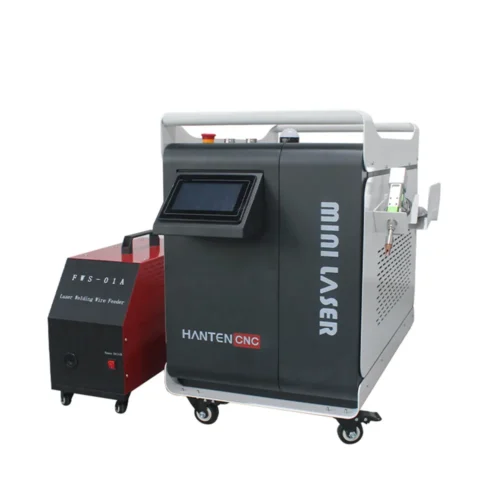Introduction
One of the most significant parts of the laser welding machine is the protective lens. Its name comes from protecting the machine’s optics and parts from splatter, debris, and fumes during welding. However, the lens is a crucial part. Like most systems, it may have problems that hinder its function.
We will discuss issues with protective lenses in laser welding machines, review possible remedies, and discuss ways to avoid such problems. A good lens maintenance and replacement program is essential for ensuring good laser welding performance.
To Explore more read articles on managing protective lenses in industrial welding. Good upkeep plans link equipment investments to planned production. They also optimize costs.
Major Problems
Lens Contamination
One of the most common issues is the build-up of contamination on the surface of the lens. Dust, fumes, and other particles may build up during laser welding. The laser power transmission efficiency drops as more material deposits on the lens.
Eventually, a thick layer of grime accumulates on the lens, hindering light transmission. This reduces the quality and penetration of laser welds and increases variations and imperfections. In some instances, the weld quality, speed, and penetration depth are significantly affected.
Solutions
Check the protective lens and clean it often. Don’t let it get too dirty. Some machines have air purge systems to blow debris off the lens between welding cycles. They can be automatic or manual.
Wear appropriate protective gear, including lens protective covers, which should be replaced as often as is advised. The disposable or reusable covers are an added layer that helps reduce particles’ accumulation.
During laser welding activity, use high-velocity cutting assist gas to reduce the amount of welding fumes and debris depositing on the lens surface.
Thermal Damage
Because laser welding implies a high level of heat production, the lenses are exposed to thermal effects during a day’s work. As the lens is heated and cooled, stress builds over time, and small cracks and defects appear within the lens glass material.
Lenses are also affected because they become cloudy and translucent due to the thermal damage, which keeps on increasing. Laser transmission decreases as the extent of the fracture network increases when the fractures penetrate the lens. Lack of heat resistance leads to lens degradation and subsequent early replacement.
Solutions
Employ special lenses designed to withstand thermal loading without fracturing internally. Specialized tempering and heat treatment of the lenses have improved resilience.
Develop an intelligent power control mechanism in the laser generator to manage the heat energy supplied to the workpiece. This will avert the problem of uneven lens heating, which may damage the equipment.
Integrate a purge cooling system into the protective lens apparatus to cool and regulate thermal fluctuations.
Physical Damage
The protective lenses also withstand scratches, cracks, and abrasion impacts during cleaning and handling accidents. The slightest surface flaws reflect the laser beam, causing energy density variation and poor weld quality.
As such, welding parts, tools, and external environment shocks expose the lens to more severe trauma. For instance, a translating part collating with the fragile lens creates immediate ruptures through the glass. If not fixed, more damage may impair the lens’s ability to transmit the beam.
Solutions
It is essential to educate machine operators on proper lens handling procedures and always cover the lens when the laser is not operating. Avoiding contact with the optical equipment reduces the chances of scratching or otherwise damaging the equipment.
Incorporate trips, stops, and motion sensors to stop the part movement as soon as the lens’ collision is detected. This halts the welding procedure before significant damage occurs if the lens is struck.
Conduct special inspections and quality checks at intervals corresponding to production cycles. Early detection means defects can be corrected before they worsen and make lens replacement necessary.
Preventative Measures
Additionally, some general precautions will help to reduce the impact of various factors that cause wear and tear to the lenses, including damage, contamination, and general wear and tear from day-to-day use. Where operating abuse is not excessive, the first is life extended by adherence to sound maintenance practice.
Some of the suggested proactive steps include: Some of the suggested proactive steps include:
It may involve recording welds, total laser on-time, or any other feature that needs to be measured. Set the lens replacement frequency based on average failure rates for specific machine models. The timed change-outs do not allow for emergencies, which can occur due to battery failure.
Check the maintenance log for problems from operation. Find which usage patterns cause recurring lens issues. Find out if poor training or high standards cause increased wear that needs adjusting.
Occasionally, lenses are returned to the factory. Re-coat or laser re-coat them to smooth the working surface. This restores their light passage ability to the original as-new standards for easier passage.
These precautions can improve the lenses. They boost their durability and quality before the following major replacements. Projected operating expenses decline and production uniformity is sustained throughout protracted utilization cycles.
Conclusion
Finally, protective lenses ensure consistent laser welding results. They also shield the beam delivery optics from various harmful factors. But, over time, contamination, heat, and wear reduce the optical transparency and beam transmission. With proper solutions, manufacturers can maximize the lens components’ life.
These lenses must be regularly inspected and maintained. This is to ensure they meet daily welding demands. It must not compromise weld quality or cause shutdowns. It lets fabricators reduce wasted time from lens troubles, which cuts productivity. Awareness of lens issues lets managers make better decisions. This helps ensure stable production and improved quality.
Keep an eye for more news & updates on My Stories List!
